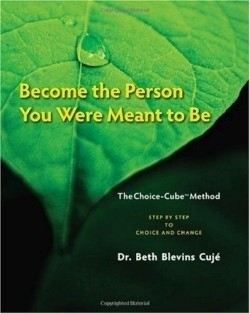Become the Person You Were Meant to Be
The author compares the mind to a large astrodome with a tiny golf ball sitting on top. The golf ball is reflective of our conscious mind—what we are actually aware of—and the astrodome is the non-conscious mind, which includes those things we’ve forgotten, ignored, or refused to have looked at. The huge discrepancy between the two is why we sometimes don’t understand our actions and why some behaviors are difficult to stop.
Enter Dr. Beth Blevins Cujé and her Choice-Cube Method, a self-help approach that consists of four key steps to help participants “cross the bridge” from shadow (unbalanced thinking) to light (living in “our healthy best real self’). This program is the culmination of the author’s experience as a therapist, workshop presenter, and university faculty member. It uses a six-sided cube called “cubi” which is depicted as a cartoon figure. The cube’s six sides represent body, emotions, mind, will, shadow, and light.
Cujé holds a doctorate in Counseling and Human Development from The George Washington University. She is certified by the National Board of Certified Counselors, is a member of the American Psychological Association, and has been in full-time private practice for twenty-five years.
Become the Person You Were Meant to Be lays out the four steps one must take in order to break a bad habit. These steps and the aspect of the self that they act on are: Recognize (Body), Interrupt/Release (Emotions), Refocus (Mind), and Replace/Act (Will). Sets of “tools” are available at each step. For example, “Recognize” means “we admit we have a problem,” and one tool used here is deep breathing.
Real-life examples lend credibility and authenticity to the program: “When Howard was a child, his mother wanted him to be perfect—an impossibility,” Cujé writes.
While the author indicates that both faith-based and secular clients, students, and workshop participants have found success with her program, readers should be aware that there are references throughout the book to a Christian God. For example the rescue/reuniting tool explains that it “uses Holy Spirit-led visualization to help you.”
In the chapter on emotions, the author includes an entire page of synonyms for the “eight shadow emotions.” These are negative emotions with the acronym PACS-FOGD, which stands for pride, anger, craving/lust, shame, fear, overwhelm, grief, and disgust. Also included here is a quiz: “Can you identify these feelings?”
The final section of the book contains the choice-cube “tools.” While it’s understandable that they are combined in one area, it might have been more helpful if this information were included closer to the chapters in which they were described and actually used.
Individuals seeking to better themselves might find that the author’s insightfulness and the Choice-Cube Method work well for them. Cujé is a perpetual cheerleader and her caring personality emanates from the pages as she encourages readers to be the best they can be.
“You can change!” she writes. “If you pay attention to your inward reactions and change them, you can change your life.”
Disclosure: This article is not an endorsement, but a review. The publisher of this book provided free copies of the book and paid a small fee to have their book reviewed by a professional reviewer. Foreword Reviews and Clarion Reviews make no guarantee that the publisher will receive a positive review. Foreword Magazine, Inc. is disclosing this in accordance with the Federal Trade Commission’s 16 CFR, Part 255.

